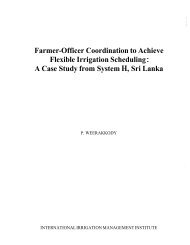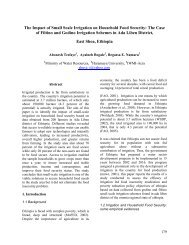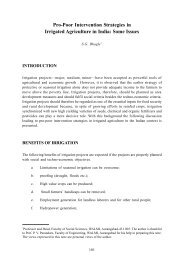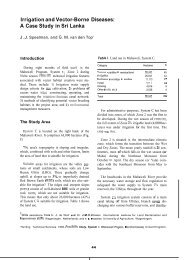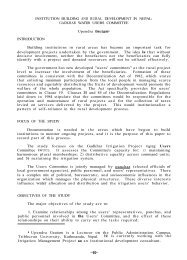WATER POVERTY IN THE NORTHEASTERN HILL REGION (INDIA)
WATER POVERTY IN THE NORTHEASTERN HILL REGION (INDIA)
WATER POVERTY IN THE NORTHEASTERN HILL REGION (INDIA)
Create successful ePaper yourself
Turn your PDF publications into a flip-book with our unique Google optimized e-Paper software.
<strong>WATER</strong> <strong>POVERTY</strong> <strong>IN</strong> <strong>THE</strong> NOR<strong>THE</strong>ASTERN <strong>HILL</strong> <strong>REGION</strong> (<strong>IN</strong>DIA): POTENTIAL ALLEVIATION THROUGH MULTIPLE-USE <strong>WATER</strong> SYSTEMSix.x.The distribution network to all the clusters needs significant improvement for enhancing the scorerelated to the ‘Access’ component.Since a major part of the ‘Capacity’ component is related to the per capita income, it is imperativeon part of any developmental agency to improve the household income for the householdswhich rank poor on that front. Since agriculture is the main occupation of a majority of thehouseholds in the village, all efforts should be directed towards improving the farm productivityin the village. This shall be possible mainly through improving access to an assured water supplysource. To start with, homestead gardens should be supplied with small but assured supply ofwater resources.The general conclusion that can be drawn from this study is that ‘Access’ and ‘Capacity’ are the twomajor factors contributing to water poverty in the village of Lampong Sheanghah. In the two mostwater poor clusters (Ching Lan, Ching Chong) and the entire village as a whole, improving the percapita income and the accessibility to water resource would lead to a much improved Water PovertyIndex and thus improved livelihoods.International Water Management Institute (IWMI) and the International Development Enterprises(IDE) have successfully implemented a project on ‘Multiple -Use Water Services (MUS)’ in the hillyareas of Nepal- an agro-ecological region of the north-western Himalayas. Findings of this project werediscussed during the NAIP Project meetings and enthused by the relevance and interest of the participantsfrom the northeast region, it was agreed to design and implement a cross-learning program for thestakeholders from the NEH region. Special capacity building program (March 3-6, 2009) implementedin collaboration with IWMI- Nepal, IDE-Nepal and Department of Irrigation of the Governmentof Nepal discussed both theoretical and practical aspects of the Multiple-Use Water Services for thehilly areas. In all 13 participants comprising of farmers, researchers and development officers fromNagaland and Sikkim states of the northeast hill region of India participated in the program organisedat Kathmandu, Nepal. The next section of the report briefly describes the concept, design, experiencesand suitable policies for implementation of the Multiple-Use Water Sevices in the hilly areas.4. Multiple-Use Water Services for the Hilly AreasMultiple Use Water Services (MUS) is a participatory, integrated, and povery reduction focussedapproach which takes people’s multiple water needs as starting point for providing integrated services.MUS is a strategy to move beyond sectoral barriers of the domestic and productive sectors andprovide for all water needs in a community (Mikhail et al; 2008). In the middle hills of Himalayas,bari is the most prevalent land type close to the homesteads and can be easily used for crops likevegetables that require protection. Despite a lack of access to canal or well irrigation, it has greatpotential for increased crop production with micro/ precision irrigation as the technology requiressmall amounts of water and can be applied on sloping lands without any danger of soil erosion.Therefore the productive portion of multiple-use water sevices can take the form of micro-irrigationof vegetables on bari land close to the homestead. Further, as rivers and streams are difficult andexpensive to access, spring water (base flow component) has become the preferred source of domesticwater for most villages (including Lampong Sheanghah and Longwa- the study villages in Nagaland26



